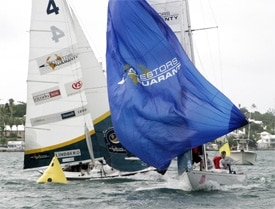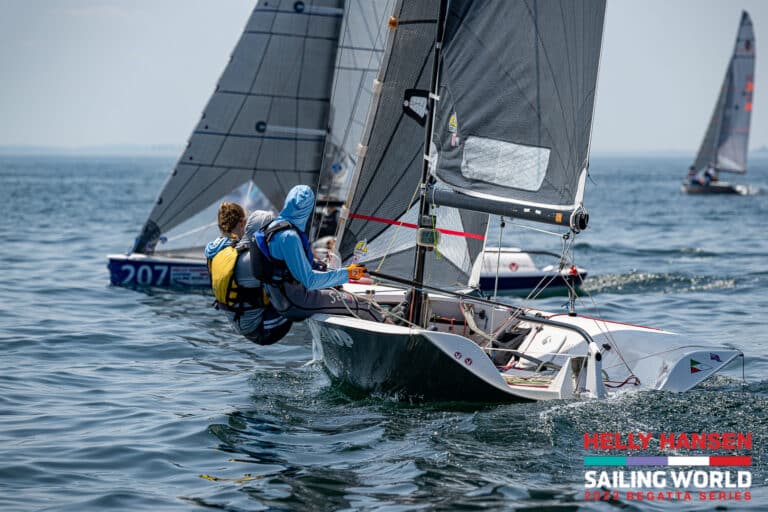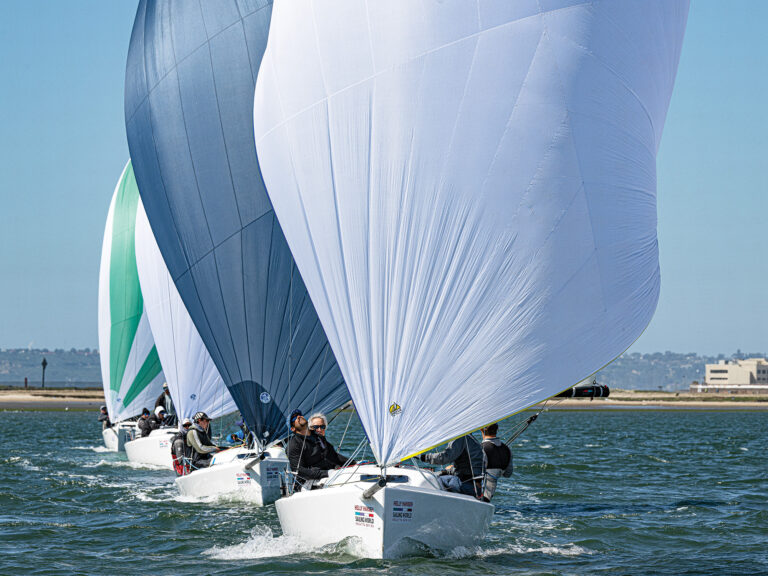
SW Weekly 051024
THE FIRST BEAT Alinghi’s Cream Continues to Rise Last week Alinghi announced that they’d named tactician Brad Butterworth as their skipper. As Butterworth noted in the press release, it won’t change much about how he or anyone else at Alinghi goes about their business. “It won’t make any difference to the way we sail the boat, everyone has their area and their responsibilities,” he said, “but I guess it will be a little bit different for me as it makes me responsible for the boat as a whole. I will be thinking about doing my job well onboard and continuing on as we have in the past.” This announcement officially fills the vacuum created when Coutts left the team and gives Alinghi, at least outwardly, a distinct chain of command: Grant Simmer and Patrick Magyar running the syndicate, Butterworth acting as skipper of the race boat and a part of the management team, and Jochen Schuemann making day-to-day decisions involving the sailing program. The announcement also puts the spotlight where maybe it should’ve been all along, on Butterworth. Alinghi dominated the 2005 America’s Cup Class season and was particularly lethal in the match racing, losing just two of 33 head-to-head competitions. They did this with three different helmsmen and while swapping crew in and out of virtually every position. Every position, that is, except tactician. While it’s hard to imagine Alinghi crossing the line for Race 1 of the 2007 America’s Cup without the remains of Coutts’ core group-Butterworth, jib trimmer Simon Daubney, main trimmer Warwick Fleury, strategist Murray Jones, and jack-of-all-trades Dean Phipps-the only person guaranteed a spot on the race boat is Butterworth. Ask him the question and he’ll most likely tell you otherwise, how he’s as much at risk of watching the 2007 Cup from the sidelines as anyone else on Alinghi’s sailing team, how they’re trying to fit together all the pieces of a complex afterguard puzzle. Don’t believe a word of it. He is as self-deprecating off the water-at least when dealing with the press-as he is ruthless on it. To get a real taste of Butterworth’s genius, you need to see him round the leeward mark behind by a few boatlengths and slowly grind in the competition. He works every little shift, forcing his opponent to tack when he least wants to and grabbing a few feet each time. By the top mark, if he’s not in the lead, he’s close enough to strike on the run. He makes it seem easy, almost inevitable. Anyone who’s ever match raced knows it’s anything but. Unfortunately, by the first leeward mark, Alinghi usually has a comfortably lead and Butterworth is content to simply stay between the opposition and the finish, though even that’s rarely a simple task. Many thought the loss of Coutts would be a fatal blow for Alinghi. To wit, the Swiss syndicate never seemed more vulnerable than during the Alinghi-BMW Oracle exhibition in Newport in June 2004, the event that brought the Coutts-Bertarelli rift into public view. But maybe the most significant absence during that regatta was Butterworth, who was in a car accident the night before the first race and didn’t sail either. In 2005, without Coutts, but with the silver-haired tactician pulling the strings-figuratively, of course, as he rarely touches a line-Alinghi has been nearly unbeatable. -Stuart Streuli James Spithill wins King Edward VII Gold Cup in Thrilling Final HAMILTON HARBOR, Bermuda (23 October 2005) – A new King has been crowned on the waters of Hamilton harbor. Australian James Spithill won the Investors Guaranty presentation of The King Edward VII Gold Cup match race championship, Sunday, beating the defending champion Russell Coutts in a thrilling decider 3:2. Spithill, 26, the Luna Rossa Italian America’s Cup helmsman and current world champion, lost the first race at the start, regained his composure in the second heat, but lost again to the 7-time Gold Cup winner in the third. This left the Australian with the uphill battle of winning the final two races, but far from buckling under the pressure, Spithill took total control of both starts and the rest is history. Spithill’s Luna Rossa crew consisted of Joe Newton (Australia), Magnus Augustson (Sweden), and Charlie McKee (USA) http://www.kingedwardviigoldcup.com/index2.html ISAF Rolex World Sailor of the Year Awards Voting to decide the ISAF Rolex World Sailor of the Year closed on October 21st. Each of the 117 ISAF Member National Authorities had been invited to cast their vote, with the deadline closing at 1600 hours UTC on Friday 21 October 2005. Click the link below to view the nominees. http://sailing.org/default.asp?ID=j1,Fh0u%60l&format=popup US SAILING Awards Nathanael G. Herreshoff TrophyLarry White (Niantic, Conn.) is the immediate past President of the Interscholastic Sailing Association (ISSA High School Sailing) and was presented with US SAILING’s most prestigious award to a standing ovation. As ISSA’s tenth President, the growth of school sailing went to full bore, from a handful of schools in New England to seven organized and active national districts nationwide. Gay S. Lynn TrophyGene Hinkel (St. Petersburg, Fla.) was presented with the Gay S. Lynn Trophy for outstanding contribution to disabled sailors and the sport of disabled sailing. Timothea Larr AwardJo Mogle (Punta Gorda, Fla.), a lifelong supporter of boating safety through education and training, has received US SAILING’s Timothea Larr Award for her lifelong commitment to standardized quality sailing education. For more, visit http://sailing.org/default.asp?ID=j67Fh0uAB&format=popup How to Call Puffs, Upwind and Down Upwind or down, the key for crews is to feed puff information to the helm. From our June 2003 issue by keelboat legend Moose McClintock. Upwind puff-calling is all about keeping your eyes forward, figuring out what the wind is doing, and counting puffs down. Downwind, you need to look back and spot where the puffs are so you can get in a good spot to make gains with them. On a windy day, especially as you fight your way off the starting line in close quarters, you can hear the calls from the talking heads of your nearest competitors: “Puff in 3 . . . 2 . . . 1 . . . followed by a lull and two steep waves.” Getting this kind of input back to the helmsman is critical, not just at the start, but all around the racecourse, because as you know, huge gains can be made by taking advantage of puffs and lulls, both large and small. For the rest of this From the Experts Story, please visit http://sailingworld.com/article.jsp?ID=201688&typeID=402&catID=596&exclude= For an online archive of From the Experts Stories, please visit http://sailingworld.com/sw_experts.jsp?typeID=402&catID=596 Star 2005 Pacific Coast Championship 1 8107 Xavier Rohart Rambeau Pascal 15 2 8156 Andy Horton Brad Nichol 16 3 8129 Mark Reynolds Hal Haenel 16.0001 4 8234 Peter Conde Andrew Hunn 18 5 8236 Steven Kelly Bill Holowesko 23 6 7995 George Szabo Eric Monroe 25 7 8222 Rick Merriman Rich Peters 27 8 7836 Iain Murray Andrew Palfrey 28 9 8082 Jeff Madrigali Anders Eckstrom 30 10 8162 Andy Macdonald Brian Fatih 37 http://www.starclass.org/search.cgi?Action=view&Event_id=610 Shosholoza Rising (Second in the Season Review Series) 2005 was a year of high peaks and low troughs for the fledgling South African America’s Cup challenge, Team Shosholoza. After a remarkable debut in 2004, where the team earned plenty of goodwill and praise for its efforts, not to mention a generous sponsorship, the South Africans came into the 2005 season with a new boat (the first Cup boat ever built in Africa), and a determination to earn points, not platitudes. But it was in Trapani where the South Africans really started to strut. With Law being replaced by the guiding hand of American Dee Smith, Shosholoza won three matches to take 10th place. That was a good start. In the fleet racing however, the team from Africa was THE story. The black boat burst out of the gates with two fifth places and a third, en route to fifth place overall – a very impressive result for any team, let alone one a shy of experience as Shosholoza. Behind them, teams like Luna Rossa, +39 Challenge and Victory Challenge, among others. For the rest of the story, please visit: http://americascup.com/en/acmag/features/index.php?idIndex=0&idContent=4537 Paul Cayard Reports on pre-Volvo Practices First time was Wednesday with ABN AMRO ONE. It was blowing about 30 and they had a special little jib and a nice set up on the main and they blew our doors off upwind. They turned and went back to the harbor first and we continued on upwind trying to sort out a few things with our rig set-up. When we turned to go back the speed immediately went up to 25 knots with just the jib and main. Then we put up the fractional kite….30 knots. ABN later told me they laid the boat down on the way in. We actually did too before putting up the kite. Got the keel stuck on the wrong side in a gybe. Nothing too major. Just went head to wind on the new gybe, got things sorted with the electronic controls, canted, and ripped off at 25 again. Today we lined up with Brasil 1 and ABN AMRO ONE again in eight knots and things were much closer. There is a big difference in sails and one thing that is becoming very apparent is that sails make a big difference in speed in this class. Speed differences are in the knots, not tenths of knots! For the rest of the story, please visit: US SAILING Hires Jim Teeters for Offshore Programs PORTSMOUTH, R.I. (October 18, 2005) – US SAILING, national governing body for the sport, announced today that Jim Teeters (Newport, R.I.) has joined the organization as Associate Offshore Director. Teeters brings to US SAILING a strong capability in yacht design and offshore rating rules. He has 24 years of experience as a yacht designer, which he gained while working for Sparkman & Stephens and Langan Design. He understands the inner workings of rating rules through a decade of membership on the IMS International Technical Committee and has long been known as the “brains” behind the AMERICAP rule. These skills combined with his naval architectural background will ensure the continued smooth growth of the new (to the US) IRC fleet. Rolex Middle Sea Race “The guys did a nice job chasing a couple of clouds on the way into Stromboli, but after getting through its lee the wind died completely down to 3-4 knots and since then we’ve covered 18 miles in the last 12 hours,” reported Campbell Field, navigator on American Willem Mesdag’s Swan 62RS Constanter. “At the moment we’re making 0.5 knots. With 370 miles to go at that rate, we’ll take 30 days to get in!” Constanter reached Stromboli 24 hours faster than they did during the windless first stage of last year’s race, but their lack of progress thanks to the current “glass out” since then is rapidly eating into this. For more on this Mediterranean classic, please visit









